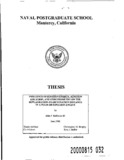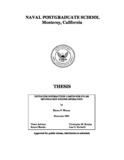Influence of ignition energy, ignition location, and stoichiometry on the deflagration-to-detonation distance in a Pulse Detonation Engine
| dc.contributor.advisor | Brophy, Christopher M. | |
| dc.contributor.advisor | Hofler, Tom J. | |
| dc.contributor.author | Robinson, John P. | |
| dc.date | June, 2000 | |
| dc.date.accessioned | 2012-08-09T19:28:33Z | |
| dc.date.available | 2012-08-09T19:28:33Z | |
| dc.date.issued | 2000-06 | |
| dc.identifier.uri | http://handle.dtic.mil/100.2/ADA380632 | |
| dc.identifier.uri | https://hdl.handle.net/10945/9314 | |
| dc.description.abstract | The feasibility of utilizing detonations for air-breathing propulsion is the subject of a significant research effort headed by the Office of Naval Research. Pulse Detonation Engines (PDE) have a theoretically greater efficiency than current combustion cycles. However, pulse detonation technology must mature beginning with research in the fundamental process of developing a detonation wave. This thesis explores various ignition conditions which minimize the deflagration-to- detonation transition distance (Xddt) of a single detonation wave in a gaseous mixture. | en_US |
| dc.description.uri | http://archive.org/details/influenceofignit109459314 | |
| dc.format.extent | xiv, 79 p.;28 cm. | en_US |
| dc.language.iso | en_US | |
| dc.publisher | Monterey, California. Naval Postgraduate School | en_US |
| dc.title | Influence of ignition energy, ignition location, and stoichiometry on the deflagration-to-detonation distance in a Pulse Detonation Engine | en_US |
| dc.type | Thesis | en_US |
| dc.contributor.corporate | Naval Postgraduate School (U.S.) | |
| dc.description.funder | N0001498WR20018. | en_US |
| dc.description.service | U.S. Navy (U.S.N.) author. | en_US |
| etd.thesisdegree.name | M.S. in Applied Physics | en_US |
| etd.thesisdegree.level | Masters | en_US |
| etd.thesisdegree.discipline | Applied Physics | en_US |
| etd.thesisdegree.grantor | Naval Postgraduate School | en_US |
| dc.description.distributionstatement | Approved for public release; distribution is unlimited. |
Files in this item
This item appears in the following Collection(s)
-
1. Thesis and Dissertation Collection, all items
Publicly releasable NPS Theses, Dissertations, MBA Professional Reports, Joint Applied Projects, Systems Engineering Project Reports and other NPS degree-earning written works.





